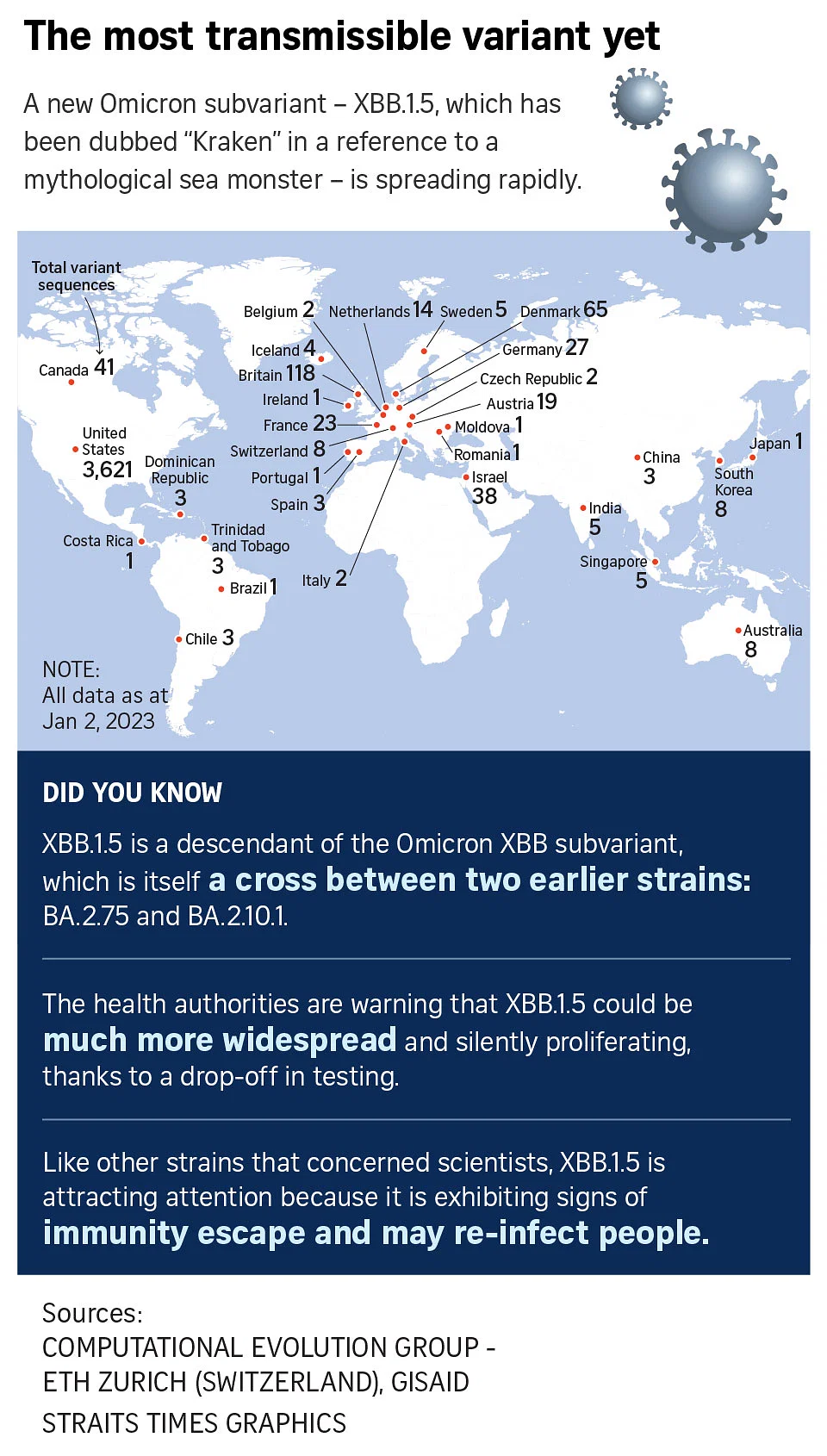January 9, 2023
NEW YORK – A new coronavirus subvariant that was first detected in 2022 has quickly become the dominant strain in the United States, picking up a creepy moniker along the way.
Nicknamed the “Kraken” variant by some, it surged through the nation and has now been identified in at least 31 other countries, according to the World Health Organisation (WHO).
Is it more dangerous? Does it spread more easily? And how will it affect China’s Covid-19 outbreak? Here are the answers:
What is the new variant?
XBB.1.5 is a descendant of the Omicron XBB subvariant, which is itself a cross between two earlier strains: BA.2.75 and BA.2.10.1.
The original XBB variant has already caused waves of infection in countries including Singapore and India, since the WHO first raised concern about it last October.
How fast is XBB.1.5 spreading?
While accounting for just 1 per cent of all Covid-19 cases at the start of December, estimates from the US Centres for Disease Control and Prevention showed that it surged to become the dominant strain by the end of the month, responsible for about 41 per cent of all infections. In north-eastern states, that figure has jumped above 70 per cent.
XBB.1.5 is “the most transmissible subvariant that has been detected yet”, said the WHO’s Covid-19 technical lead, Dr Maria Van Kerkhove, during a press conference on Jan 4.
While only 31 countries have reported cases caused by it, the health authorities are warning that it could be much more widespread and silently proliferating thanks to a drop-off in testing.
In other countries, the proportion of infections caused by XBB.1.5 has remained lower, although the picture may rapidly change.
Estimates from the Wellcome Sanger Institute found that the variant made up around 4 per cent of Covid-19 infections in England as at mid-December, while Canada has found a handful of such cases.
Scientists pointed out that the sub-variant has a much stronger affinity to ACE2, a key receptor for the virus, which allows it to bind more easily and boosts its transmissibility.
Is it more dangerous than previous variants?
There have not been significant differences in severity reported between cases caused by XBB.1.5 and previous variants.
Like other strains that concerned scientists, however, XBB.1.5 is attracting attention because it is exhibiting signs of immunity escape. This means it has an ability to evade natural immunity or previous protection provided by vaccines, and re-infect people who have recovered from an earlier bout of Covid-19.
Data remains limited on XBB.1.5’s severity and its propensity to cause severe disease or death. Previous therapies to tackle Covid-19 – like monoclonal antibody treatments – were rendered ineffective by previous strains. This trend is set to continue with the new variant.
Scientists in a recent peer-reviewed article published in the journal Cell warned that subvariants like XBB.1.5 pose “serious threats” to current Covid-19 vaccines.
Higher transmissibility also means more people are likely to get infected, and thereby suffer severe outcomes.
It is unclear if the US’ experience with XBB.1.5 will extend to other countries. America, unlike many other developed nations, suffers from low vaccination rates. Only 15 per cent of the population aged five and above has received an updated bivalent booster dose. The rate is slightly better among the vulnerable elderly population, including those aged 65 and above, with fewer than four in 10 receiving the shot.
Hospitalisation rates for Covid-19 are already rising, amid a surge in other winter season infections like influenza. The WHO plans to release an updated assessment on the variant’s risks in the coming days.
Has it reached China yet, and what will be its impact?
China, which is going through a major wave of infections after dismantling its stringent zero-Covid policy in recent weeks, has yet to report any domestic cases of XBB.1.5.
Shanghai has detected three infections caused by the variant and said that all were imported cases.
But health agencies across the world, including the WHO, have raised concerns that China is not providing enough genomic sequencing information to come to any definitive conclusions. In the meantime, the country’s Covid-19 wave is being driven by two other Omicron strains: BA.5.2 and BF.7.
Together, they account for 97.5 per cent of all local infections, according to genomic sequencing data from the Chinese Centre for Disease Control and Prevention.
While the authorities have tried to allay fears that the XBB variant will drive new waves of infection, the public – already spooked by the strained healthcare system and limited availability of treatments – is not convinced.
A widely circulated viral post claiming that the XBB variant may lead to vomiting and diarrhoea led to an anti-diarrhoeal medication selling out across China as panicked buyers snapped it up.

Where did the ‘Kraken’ name come from?
Covid-19 variants are currently named by an expert group convened by the WHO. It identifies so-called variants of concern that have potential global public health significance, such as reducing the effectiveness of current pandemic measures, using the Greek alphabet.
Previous strains like Alpha, Beta and Delta fell under the convention. But the last Greek-named variant, Omicron, emerged more than a year ago and left no room for the emergence of other significantly different strains.
Omicron has spawned multiple lineages, including XBB.1.5, and their names stem from a mix of letters and numbers known as “Pango”. This has led to the rise in popularity of informal online nicknames, including “Kraken”.
The moniker for XBB.1.5 was proposed by an evolutionary professor on Twitter to match the strength of the new strain with the mythological sea monster. BLOOMBERG

